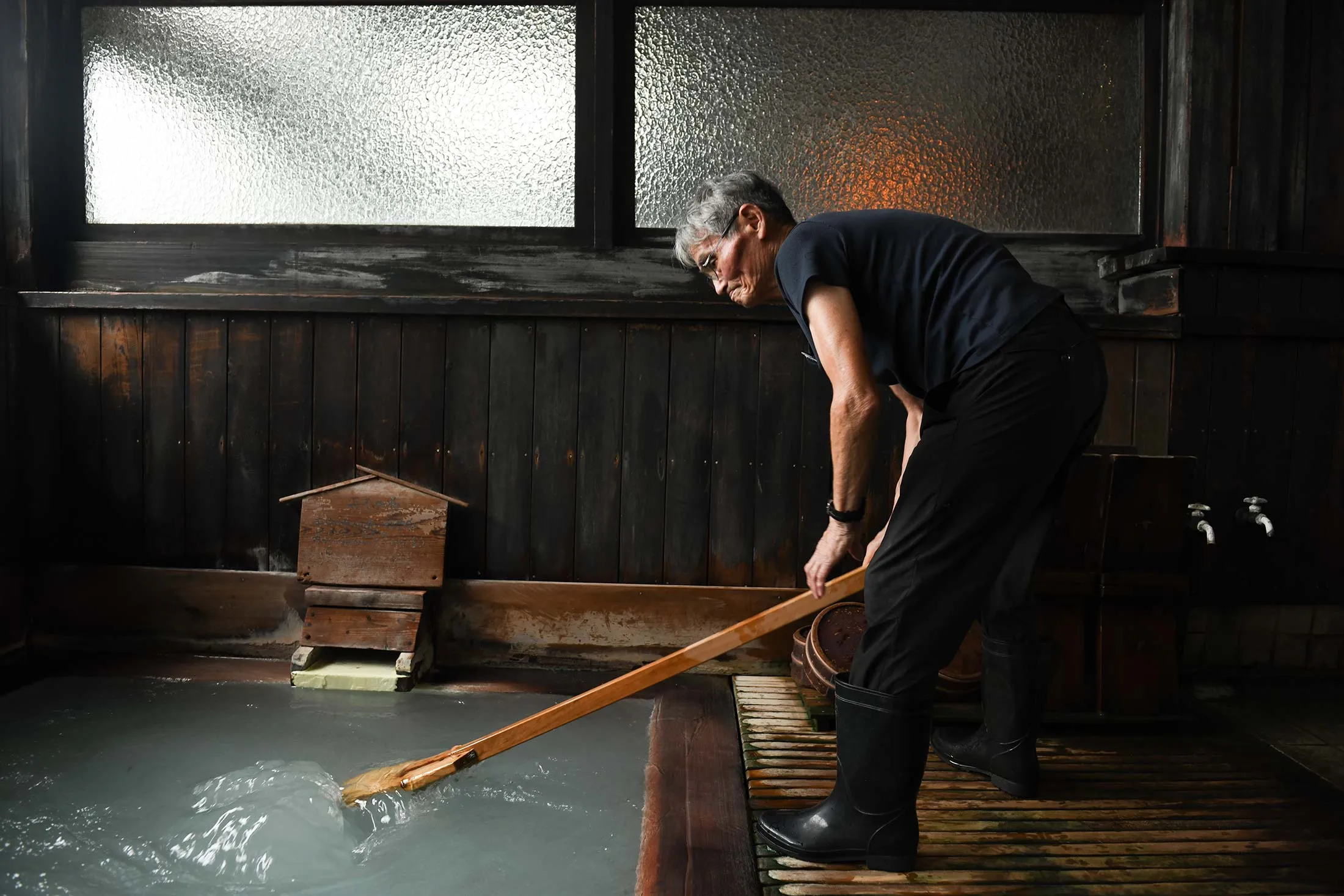
In agonizing decisions for owners, a once-protective society lets the market take its course.
The Zao Onsen Ski Resort in northern Japan offers Aspen‑style deep powder and trails lined with its famed “snow monsters,” pine trees glistening with ice and snow from biting Siberian winds. For generations the Sato family operated a thriving lodging business nearby. Its flagship property, Hotel Oak Hill, has 30 rooms, soaring ceilings and access to the region’s hot springs for après-ski unwinding.
The company flourished in Japan’s post-World War II economic boom. Children from a famous Tokyo private school, known for educating aristocratic families, came every winter, their photos lining the hallways of the hotel’s more modest sister property. Called Yoshidaya, it was a ryokan, or traditional Japanese inn, that welcomed guests with communal baths, futons for sleeping and local cuisine. “The ryokan was our life, family and business,” says Chigusa Sato Nolen, 57, who grew up skiing at the resort and spent her early childhood living full time in the inn.
But during the long stagnation after Japan’s economic bubble of the 1980s burst, her family’s hotels struggled. They earned just enough to pay interest on their debts, joining the growing ranks of companies that survived in part because the Bank of Japan slashed interest rates to zero so borrowers wouldn’t default on their loans. By 2010 almost 1 in 5 companies limped along because of bailouts and other financing relief, rather than tackling their fundamental problems. In 2008 three economics professors, one from Japan and two from the US, coined a term for these enterprises: “zombie companies.”
Proprietors were reluctant to shut them down. Unlike in the US, where President Donald Trump bounced back from his companies’ bankruptcies, the stigma of failure runs deep in a business culture defined by diligence and honor. Lifelong commitment to workers, who offer loyalty in return, is the norm. “If you travel outside of big cities, you’ll see quite a few places where you wonder how these people are making a living at all,” says Kazuyoshi Komiya, a consultant who helps small and medium-size companies with turnarounds. “Japan has been overprotective of them.”
Now the country’s financial landscape is changing. In March 2024 the Bank of Japan increased interest rates for the first time in 17 years, reflecting an improving economic climate and rising prices. The Japanese government is embracing what mid-20th century economist Joseph Schumpeter called capitalism’s “creative destruction,” the need for innovators to replace weaker rivals. Regulators have been pushing companies to improve their governance, and recently Japan passed a law to streamline restructurings and encourage turnarounds. “It’s important for the corporate sector to see healthy regeneration,” Yasuo Goto, a professor at Seijo University who studies zombie companies, said in a presentation last year at the economy ministry’s Small and Medium Enterprise Agency. The Tokyo Stock Exchange is pushing underperforming public companies to become more profitable and engage more with investors. In 2024 the number of zombie companies began to edge lower for the first time in seven years. In the year ended in March, bankruptcies climbed 13%, to 10,070, the most since 2014.
For now bankruptcies have yet to claim larger companies, and people have generally been able to find new jobs, thanks to a chronic labor shortage in Japan. But Schumpeter also recognized the potential for the dislocation of failing companies to lead to social unrest. “A small cohort of winners versus everyone else risks destabilizing the economy and society,” Goto says.
Across town from Oak Hill, Zao Center Plaza—a commercial complex with a hot spring, an inn and restaurants—went bust almost two years ago. Employees lost their jobs, and the buildings were razed. All that was left was roughly ¥1 billion ($6.8 million) in unpaid loans and a patch of dirt. “The debt repayments were a huge burden,” says Masaru Funami, who was hired by the owners to run the facility and was the last to turn off the lights. The plaza made money only two months out of the year and couldn’t raise prices enough to cover costs. “Even if someone had stepped in, it would have been tough to turn it around,” Funami says. “In the end it was the right time to let go.”
Last year the Sato family faced the same painful choice.
For more than a millennium, travelers have journeyed to the Zao Mountains, drawn by their restorative hot springs. The Yoshidaya ryokan first appears in records from the early 1800s, when shoguns, or military rulers, still governed Japan. Situated in the Zao Onsen district of the city of Yamagata, it was among 17 original inns that welcomed summer visitors seeking healing waters after the snow had melted.
About a century ago, the area began reinventing itself as a winter getaway, opening its first slope to those eager to adopt novel Western sports such as skiing. In a booming economy, tourism surged further in the 1960s, and a new highway later improved access. The expanding middle class flocked to ski resorts in winter and beaches in summer.
Built with wood and last updated in the 1950s, the Sato family’s Yoshidaya was a creaky labyrinth of two dozen rooms scattered over three floors. Despite the steep stairs and lack of toilets in some rooms, Gakushuin, the celebrated school in Tokyo for the gentry, chose to send its students every winter to learn to ski.
For Chigusa Sato, whose big eyes and easy smile have long put customers at ease, Yoshidaya was simply home, with life shaped by the rhythm of arriving guests. Her father, a skilled skier, sent his son and daughter out on the trails with the students. Flipping through an album, she shares pictures of the ryokan full of people, her family, staff and guests. In one photo she’s standing next to the current emperor’s younger sister. Chigusa lived on the second floor of Yoshidaya until she was about 8, when her father built a large house nearby. But she always ate at the ryokan.
As Japan’s economy swelled in the ’80s, there was plenty of disposable income to spend on Hondas, Walkmans and Ralph Lauren polo shirts. Businesses thrived, and many families eagerly spent their rising fortunes.
When Subaru Corp. introduced a new four-wheel drive that could climb the region’s snowy roads, “my father bought one,” Chigusa says. “I asked for a red car, so that’s what he got.” To prepare her brother, Naoki, to take over the business, their father sent him to hotel management school, then later on a two-week tour of Europe’s grandest hotels.
In 1989, rattled by a rumor that the Gakushuin school was scouting for better locations for its winter trips, Chigusa’s father decided to expand. He picked a plot uphill from Yoshidaya, just a five-minute walk from the ski lifts, and borrowed ¥400 million to build a new hotel. He named it Hotel Oak Hill, after the trees on the land, and put Naoki in charge. In an era of easy money and soaring land prices, Chigusa’s father took out an additional ¥200 million loan to add an open-air bath.
That year the Nikkei 225 stock index peaked after rising sixfold over the prior decade; investors began to lose faith that Japanese manufacturing and finance would dominate the world. The property market cooled, fueling a vicious cycle of falling asset prices and souring bank debt. As deflation deepened in the 1990s, people cut back on leisure travel. Annual visitors to the area halved from a prior peak of 2 million.
As bookings dried up, Chigusa’s father and brother struggled to rein in escalating costs. They’d misjudged the heating demands of the expansive great room; cutting energy expenses meant guests shivering in the cold.
“One mistake meant firing employees. Some of them were old and would have found it difficult to find jobs again.”
Despite its modern appearance, the hotel operated more like a traditional ryokan, where breakfast and dinner are included with lodging. A typical evening meal began with seasonal appetizers and sashimi, followed by a hot pot of thinly sliced premium Yamagata beef and vegetables in a simmering broth; grilled fish; rice and soup, then finished with fruit and cake for dessert.
The effort needed to prepare and serve multicourse meals created high fixed costs, but cutting back threatened to turn away guests, especially loyal seasonal visitors. The need to lay out futons in tatami straw-mat rooms every night also kept labor costs high.
Gakushuin kept sending its students every winter, but that wasn’t enough to make up for the drop in tourism revenue. Chigusa’s father and brother cut the price of overnight stays in half, to about ¥6,000. They managed to stay open partly because they were the only place in town that welcomed travelers with pets.
During those years, Chigusa left her home, which she says gave her “no breathing room,” to study in Tokyo. After gaining some fluency in English, she found work on a US military base, where she met her American husband and added Nolen to her last name. Chigusa returned to the resort area in 2009 to care for her ailing mother. They muddled along, her father and brother barely keeping the business afloat. Virtually every yen went toward interest on the ¥600 million loan, while the principal remained untouched.
Seven years ago, Naoki suddenly died of a stroke at age 54. Chigusa believes the stress of trying to keep the doors open for far too long killed him. Then, less than a year later, her father died of cancer. Chigusa inherited the inn and hotel and the debt.
Around the same time, her nephew, Yuki Sato, was getting ready to graduate from university. He’d long dreamed of attending hotel management school after college, but those plans faded as the family business declined. When his father died, Yuki rushed home—still burdened with hefty student loans.
Again living on-site, aunt and nephew divided responsibilities: Chigusa oversaw Yoshidaya, while Yuki managed Oak Hill. They learned for the first time the precarious state of the enterprise’s finances. They were losing more than ¥30 million each year. “We couldn’t make a move,” Yuki says. “One mistake meant firing employees. Some of them were old and would have found it difficult to find jobs again.”
They scraped by for a few more years, and even looked for a buyer for Oak Hill, but failed because the property didn’t include rights to the hot spring. They leased access instead. In April 2024 a senior manager from Kirayaka Bank Ltd., instead of their usual banker, appeared, asking to speak with Chigusa and Yuki.
He explained, bluntly, that the bank could no longer carry their loan, leaving them to find alternate financing or lose the company. Jimoto Holdings Inc., the bank’s parent company, says it took the step because of a change in policy: It no longer worked with businesses unlikely to see improved cash flow. (The company declined to comment on specific borrowers.) Ultimately, Chigusa chose bankruptcy proceedings to liquidate the company, which owed the bank ¥597 million, according to a regulatory filing. As insolvency proceedings began, she drew up a short list of anyone who might buy the hotels and keep them running.
That’s when the Okazakis stepped in. Like Chigusa’s family, the Okazaki clan had been in the region for generations, operating another ryokan—Takamiya, just up the street—since the early 1700s. They’d been able to weather Japan’s long stagnation by avoiding the construction rush of the bubble years while diversifying their customer base.
As the economy began to pick up, the Okazakis found a winning strategy: modernizing facilities, controlling expenses and embracing online reservations to tap into a growing wave of international ski tourists attracted to Zao’s powder and picturesque runs.
The Okazakis, who already operated six other accommodations in the area, bought the Chigusa family’s real estate from the lender. The price wasn’t publicly disclosed, but Yuki says it was a fraction of what their company owed the bank.
Hiroto Okazaki, who runs the family business with his father, says he invested an additional ¥25 million in upgrades at the hotel. He replaced futons with modern beds, installed locks linked to a digital check-in system and switched to buffet-style breakfasts as the only meal offered. The hotel was renamed the Onsen & Stay Oak Hill, to promote its hot springs, or onsen in Japanese.
Like Chigusa and her nephew, Okazaki grew up in his family’s ryokan before moving into a new house. The two boys skied on the same local team. Hiroto went to the US for an elite education, at Cornell University, where he studied at the school’s top-ranked hotel management program. He returned to work for his father.
As chief operating officer, Okazaki oversees the Takamiya group’s annual sales of about ¥3 billion. Instead of working at an office, he roams among various properties, restaurants and projects in his mother’s Mercedes-Benz wagon. He tries to visit all the hotels in the area about once a week and prefers to drop in casually to talk to managers and staff.
So far, Okazaki’s turnaround strategy is paying off: Oak Hill is targeting ¥195 million in sales this year and a profit margin of 30%. “We knew we could run it better and revive them,” says Okazaki, 35 and athletic, wearing a North Face T-shirt, khaki shorts and sandals. “It’s an important business that failed to cater to a new customer base.” The Okazakis also bought at a good time, as Japan enjoys a surge in tourism.
When it came to Oak Hill, one crucial decision was obvious from the start. “We rehired their employees and previous owners,” Okazaki says of asking Chigusa and her nephew, Yuki, to stay. “They’re conscientious people and favored by many, many customers.”
Yuki, who’d assumed he’d have to find a new job, stayed on. With his mother, he still lives in a small house attached to Oak Hill and earns a monthly salary of about ¥250,000. While that’s only two-thirds of the national average, it’s stable, and he doesn’t have to pay rent or for most of his meals. When times were tough at Oak Hill, Yuki often skipped his own paychecks to preserve cash and used his personal credit card to cover expenses.
As hotel manager, he still works a packed day—stocking supplies, handling guest checkouts, guiding visitors to breakfast and managing cleanup. Despite the busy routine, joining a larger operation means he now can take vacation days. “It’s much easier to take time off now,” Yuki says, wearing the hotel’s new uniform, a green shirt and black pants.
Recently the new bosses approved a proposal from Yuki and other employees to turn part of the great room, with its floor-to-ceiling views of the forest, into a cafe. Construction is already underway, with the goal of opening for business this year and drawing in more nonhotel patrons while offering guests a place to relax during the day. “In the past, I couldn’t act on ideas because there was no budget,” Yuki says. “I’ve never seen the upside of the business before, so that’s new to me.”
For her part, Chigusa says she’s glad to have a new job, even if it’s a variation on the one she had as an owner. Separated from her husband, she lives alone in a small room tucked behind Yoshidaya’s reception area. After her mother died in 2020, she emptied out her family’s six-bedroom house and now rents it out to ski instructors each winter.
Chigusa had to give up her leased red Nissan Leaf when the business collapsed, and she bought a used van from the hotel for ¥30,000. She wakes up before 5:30 a.m. every day and cooks breakfast for herself and the staff before saying goodbye to departing guests.
Life isn’t easy, but for Chigusa the bankruptcy lifted an enormous burden, a testament perhaps to the redemptive possibilities of allowing the forces of creative destruction to take hold. Rather than a failure, she says, she considers the closure of her family’s centuries-old business one of her “proudest and most necessary decisions.” “If I passed the business to Yuki, he would have ended up like his father, and that’s too much for me to bear,” she says, tears welling up. “I knew I had to somehow put an end to it.”
Matsuyama reports from Bloomberg’s Tokyo bureau.



